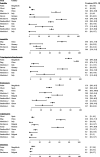Prevalence and Antimicrobial Resistance of Bacteria in Children With Acute Otitis Media and Ear Discharge: A Systematic Review
- PMID: 34166300
- PMCID: PMC8274581
- DOI: 10.1097/INF.0000000000003134
Prevalence and Antimicrobial Resistance of Bacteria in Children With Acute Otitis Media and Ear Discharge: A Systematic Review
Abstract
Background: Of children with acute otitis media (AOM), 15%-20% present with acute onset ear discharge due to a spontaneous perforation of the tympanic membrane (AOMd). This review aims to quantify the prevalence and antimicrobial resistance (AMR) status of bacteria in children with AOMd in the pneumococcal conjugate vaccine (PCV) era.
Methods: Systematic searches were performed in PubMed, EMBASE and Cochrane Library from inception to June 7, 2019. Two reviewers extracted relevant data and assessed risk of bias independently. All English studies reporting any prevalence and/or AMR data of bacterial middle ear isolates from children with AOMd were included. Risk of bias was assessed using the Joanna Briggs Institute Critical Appraisal checklist.
Results: Of 4088 unique records retrieved, 19 studies (10,560 children) were included. Overall quality was judged good. Streptococcus pneumoniae (median 26.1%, range 9.1%-47.9%), Haemophilus influenzae (median 18.8%, range 3.9%-55.3%), Staphylococcus aureus (median 12.3%, range 2.3%-34.9%) and Streptococcus pyogenes (median 11.8%, range 1.0%-30.9%) were the most prevalent bacteria. In 76.0% (median, range 48.7%-100.0%, 19 studies, 1,429 children) any bacterium was identified. AMR data were sparse and mainly limited to S. pneumoniae. We found no evidence of a clear shift in the prevalence of bacteria and AMR over time.
Conclusions: In children with AOMd, S. pneumoniae and H. influenzae are the 2 predominant bacteria, followed by S. aureus and S. pyogenes in the post-PCV era. AMR data are sparse and no clearly change over time was observed. Ongoing surveillance of the microbiology profile in children with AOMd is warranted to guide antibiotic selection and to assess the impact of children's PCV status.
Copyright © 2021 The Author(s). Published by Wolters Kluwer Health, Inc.
Conflict of interest statement
The authors have no conflicts of interest to disclose.
Figures
References
-
- van den Broek d’Obrenan J, Verheij TJ, Numans ME, et al. . Antibiotic use in Dutch primary care: relation between diagnosis, consultation and treatment. J Antimicrob Chemother. 2014;69:1701–1707. - PubMed
-
- Rovers MM, Glasziou P, Appelman CL, et al. . Antibiotics for acute otitis media: a meta-analysis with individual patient data. Lancet. 2006;368:1429–1435. - PubMed
-
- Damoiseaux RAMJ, Venekamp RP, Eekhof JAH, et al. . NHG-Standaard Otitis media acuta bij kinderen (derde herziening). Huisarts Wet. 2014;57:648.
Publication types
MeSH terms
Substances
LinkOut - more resources
Full Text Sources
Medical



